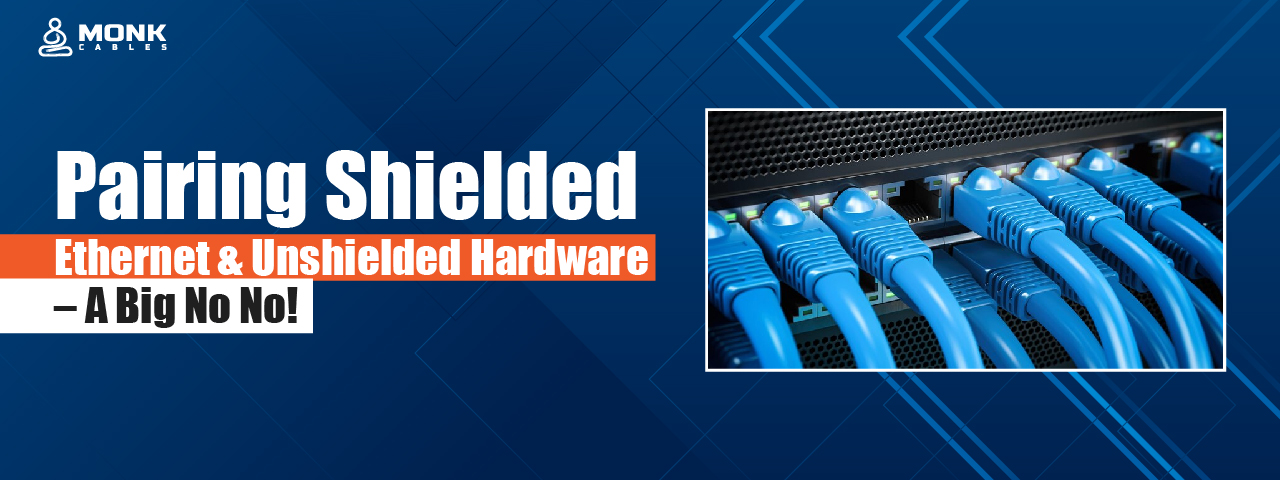Pairing Shielded Ethernet & Unshielded Hardware – A Big No-No!
Ethernet cables are a critical component of modern networking infrastructure, transmitting data between devices at high speeds and over long distances. Shielded Ethernet cables are designed to provide protection against electromagnetic interference (EMI) and radio frequency interference (RFI), ensuring reliable and efficient data transmission. However, some network administrators may opt to use shielded Ethernet cables with unshielded hardware due to cost constraints or other factors. While this approach may be tempting, it can result in decreased performance, increased interference, and potentially even damage to the network equipment. In this context, it is important to understand the potential implications of using shielded Ethernet cables with unshielded hardware.
Today, we’ll talk about why pairing shielded Ethernet cables is not a good idea with unshielded hardware. Let’s dive right into it.
The Dos & Don’ts
Dos and Don’ts of Using Shielded Ethernet with Unshielded Hardware:
Dos:
Use shielded Ethernet cables only in areas with high levels of EMI or RFI. Shielded cables are most effective in environments with a lot of interference, such as near power lines or industrial equipment.
Properly ground the shielded Ethernet cable to prevent the build-up of static electricity and reduce the risk of electrical shock.
Use a high-quality surge protector to protect the network equipment from voltage surges and spikes.
Test the shielded Ethernet cables for proper continuity, resistance, and impedance before installing them.
Use shielded Ethernet cables with other shielded equipment to maintain compatibility and ensure optimal performance.
Don’ts:
Do not use shielded cables with unshielded hardware unless absolutely necessary. Using shielded cables with unshielded hardware can cause ground loops, increase noise and interference, and potentially damage the equipment.
Do not mix and match different types of Ethernet cables or hardware. Using cables or equipment that are not compatible can result in connectivity issues, data loss, or even equipment damage.
Do not install shielded Ethernet cables near sources of high voltage, such as power transformers or electrical lines, without proper protection and grounding.
Do not use shielded cables as a substitute for proper grounding. Proper grounding is essential for safety and equipment protection.
Do not neglect proper installation and maintenance procedures for shielded cables. Improper installation or neglected maintenance can lead to cable damage, signal loss, or other issues that can affect network performance.
Disadvantages of This Pairing
Using shielded Ethernet cables with unshielded hardware can result in several disadvantages, including:
Grounding issues: Shielded cables require proper grounding to function correctly. If the hardware they are connected to is unshielded, grounding can be a challenge. Poor grounding can lead to ground loops, which can cause interference and noise in the network.
Cost: Shielded cables are typically more expensive than unshielded cables. If the hardware is not shielded and there is no compelling reason to use shielded cables, it may not be cost-effective to invest in them.
Compatibility issues: Shielded cables may not be compatible with unshielded hardware. Mixing and matching different types of cables and hardware can cause connectivity issues and data loss.
Interference: Shielded Ethernet cables are designed to protect against electromagnetic interference (EMI) and radio frequency interference (RFI). If the hardware is unshielded, it can be more susceptible to interference, which can lead to poor network performance.
Damage to the hardware: Shielded cables can carry a higher voltage than unshielded cables. If they are connected to unshielded hardware, the higher voltage can damage the equipment.
Overall, using Ethernet cables with unshielded hardware can cause compatibility issues, interference, and potential damage to the equipment. It is important to carefully consider the potential disadvantages and evaluate the need for shielded cables in the specific network environment.
Conclusion
In conclusion, while shielded cables are designed to protect against electromagnetic and radio frequency interference, using them with unshielded hardware can lead to several potential issues. Grounding, compatibility, interference, and cost are among the factors that must be carefully considered when deciding whether to use shielded Ethernet cables with unshielded hardware.
In some cases, it may not be cost-effective or necessary to invest in shielded cables if the hardware is not shielded. However, in high-interference environments, it may be essential to use shielded cables to ensure reliable network performance. Ultimately, it is crucial to evaluate the specific network environment and carefully weigh the potential advantages and disadvantages before making a decision on the use of Ethernet cables with unshielded hardware.

